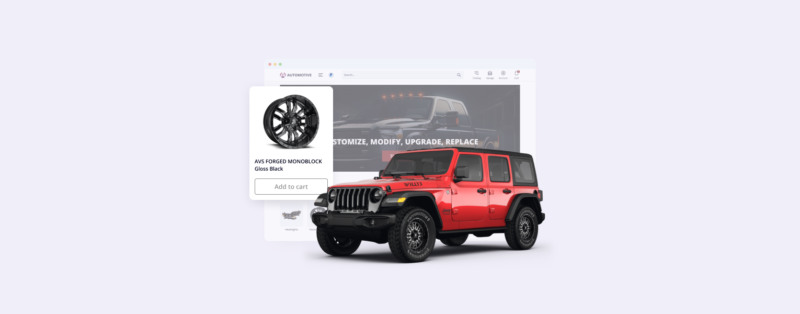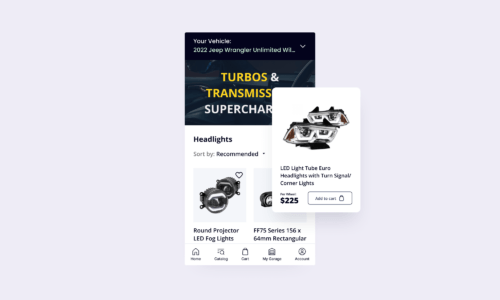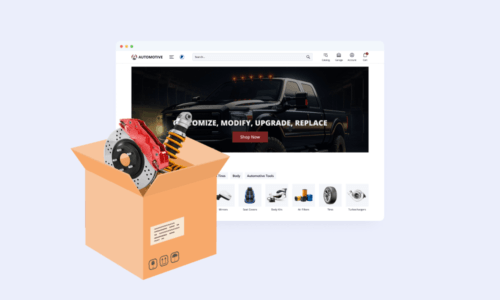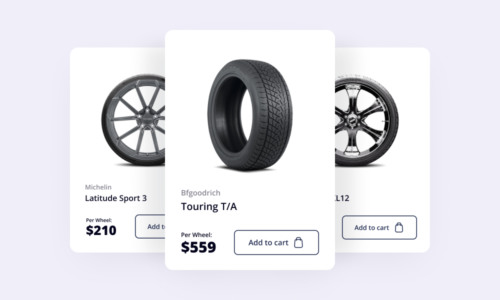How to Sell Auto Parts Online: 7 Keys to Success

Whether you are in search of new business opportunities or a seasoned auto parts seller looking to expand your business, you’ve come to the right place. In this guide, we’ll break the broad question of how to sell auto parts online down into 7 specific know-whats and know-hows to guide you through the whole process of building an automotive eCommerce business.
Without much further ado, let’s dive in.
1. Know your market: How to choose the right niche
When choosing your niche, you should do diligent market research in order to figure out the demand, define the margins you can afford, manufacturer prices, calculate the cost of shipping and fulfillment, estimate logistics issues, etc.
Don’t skip this step even if you have been in the automotive eCommerce for a long time: Even though it is a rather conservative market, it’s dynamic enough for new opportunities to have arisen since you did your last market research.
If you have an offline business that you’re looking to expand into online, it’s also essential to identify the opportunities and potential logistical pitfalls.
Here are 8 steps recommended for conducting market research when selling car parts online:
1. Identify target market
Determine the target market for the auto parts you want to sell. Consider factors such as age, gender, location, vehicle type, and specific market needs.
2. Research competition
Conduct extensive research on other businesses in the online auto parts market. Look for opportunities where you can differentiate yourself, such as selling underrepresented auto parts or offering unique customer service.
3. Determine demand
Investigate the demand for auto parts, including popular makes and models, current market trends, and specific customer needs regarding auto parts.
4. Analyze pricing strategies
Determine a pricing strategy that is competitive and sustainable while meeting economic and customer-based requirements for your business.
5. Build your brand
Develop a brand approach that stands out and attracts your target buyers, such as a concise slogan, high-quality pictures, or a memorable logo.
6. Choose a sales platform
Selecting a suitable sales platform that works best for your business. Options include marketplaces such as Amazon or eBay, eCommerce websites, and social media platforms.
7. Market strategically
Develop a comprehensive marketing strategy, including email marketing, affiliate marketing, social media marketing, paid advertising, and content creation.
8. Review and adjust
Monitor progress, review and adjust your marketing strategy, pricing plan, distribution channels, and outreach activities to address market trends or changes and maintain customer satisfaction.
2. Know your demand: What to sell
‘Auto parts’ is as broad a term as ‘fruit and vegetables’ and can include many narrower categories: spare parts, interior, exterior, headlights, wheels and tires and many more. Each of these, in turn, can be further divided into specific manufacturer brands, parts for specific vehicle types or even for specific car models. Let’s not get that granular and just see the main most popular categories currently in demand in the automotive industry.
Wheels and Tires
Actually, the more accurate phraseology would be ‘wheels and suspension’ as it includes everything from wheels to tires to shocks and struts to hubcaps.
While they are typically classified as external parts due to similar selling patterns, the installation process for these parts is more complex and requires the assistance of a shop or mechanic.
Due to these specifics, these parts are often purchased by other businesses rather than directly by the customer, meaning that a B2B approach is necessary, with a shipping plan to facilitate their delivery, accurate fitment data from parts suppliers.
When it comes to selling wheels and tires online though, you should enable your customers to narrow their search by advanced filtering (diameter, width, offset, tread width, etc.), fitment check, and optionally provide the ability to set up custom wheel or tire dimensions.
Another nice feature to have on a website selling wheels and tires is a visualizer interface so that your customers can see how different product options will actually look on their vehicle. This is how it looks in X-Cart with the AutoSync visual vehicle studio enabled:
Interior
Such parts and accessories as heated seats, seat covers, carpets, lighting, cleaning tools and kits, ventilation systems, etc. fall into this category. These products are designed to enhance the overall comfort and convenience of the vehicle’s interior while also offering protection from wear and tear.
They don’t really require any special sales techniques, website interface changes or advanced fitment check beyond your normal business approach. Additionally, many of these items need to be replaced regularly, which makes the demand ever-green.
Exterior
Another great category to tap into is exterior parts and accessories. Some of the items that fall under this category are bumpers, fenders, grilles, hoods, mirrors, spoilers, roof racks, and splash guards.
Other exterior car parts and accessories can include door handles, door hinges, fuel tanks, exhaust systems, headlights, taillights, and window tinting. These parts form an integral part of a vehicle’s structure, providing protection and support while also contributing to its overall aesthetic value.
Many of these parts are perfect for selling on online platforms, such as eBay, and/or in an online store of your own. However, most of them require accurate fitment information to be in place and easily accessible.
Maintenance parts
A few examples of maintenance parts are oil and air filters, spark plugs, fluids (such as coolant and oil), lightbulbs and headlights, batteries, timing belts, etc.
These parts are essential to the proper functioning and longevity of a vehicle, and regular maintenance of these parts can help prevent breakdowns and costly repairs in the future. In addition to regular checks and replacements of these parts, regular inspections of the vehicle’s mechanical components and functionality are also important for proper maintenance. This makes the demand even more ever-green than that of interior parts.
These items are also normally available in car workshops and showrooms, which makes them your potential target market as well.
Some of the other popular categories in the automotive industry are replacement parts for popular car models (e.g. Jeep Wrangler), specialty products (racing tires or off-road equipment), aftermarket performance parts (upgrades to the engine, exhaust systems), and more.
3. Know your surroundings: Who sells auto parts online
The information below is not only the list of your potential competitors, but also a list of opportunities to scale your business by offering your products via different sales channels and by partnering with dealers and manufacturers to get lower cost prices and be able to provide a wider choice of goods in your store at competitive prices.
eCommerce websites
Many eCommerce websites, such as Amazon, eBay, and eBay Motors, offer a platform for sellers to list and sell auto parts and accessories online. These websites have a large customer base and can offer a wide range of products and marketplaces.
Independent auto parts retailers
Independent auto parts retailers, such as AutoZone and Advance Auto Parts – and potentially yourself, – may also sell car parts online. These retailers often have established brick-and-mortar stores and eCommerce websites that make it easy for customers to purchase the parts they need and have them delivered directly to their home.
Auto manufacturers and dealerships
Some auto manufacturers and dealerships also sell car parts online, particularly replacement parts for their own brands. This can be a good option for customers who need specific parts for their vehicle and want to ensure that they are getting genuine parts.
Online marketplaces
Online marketplaces, such as Car-Part.com and PartsMarket, specialize in the sale of used and salvaged auto parts. These platforms allow buyers to search for specific parts based on make, model, and year, as well as providing pricing information and shipping options.
4. Know your buyer persona: Who buys auto parts online
Identifying your target buyer is critical when constructing an eCommerce website. If you have an existing website, use analytics tools such as Google Analytics to assess the profile of your current users. For those without a website, online market research is available to explore the behavior of the automotive aftermarket buyers and sellers.
Being familiar with your audience offers valuable insights into the best methods of selling auto parts online. Examples of such audiences include auto shops, local garages, vendors, and B2B wholesalers, while end consumers may include automotive enthusiasts or individuals seeking a specific part for their own vehicle.
By identifying your target demographic, you can better tailor your marketing efforts to boost customer satisfaction and increase online sales.
5. Know your opportunities: How to start selling auto parts online
Selling car parts online requires more than just building an eCommerce website. Before starting, it is important to conduct pre-planning and research. Here are a few helpful tips:
- Reach out to local mechanics and car enthusiasts to understand their user experience and pain points.
- Research competitors across all sales channels and determine pricing strategies.
- Contact suppliers for quotes and send purchase orders to ensure quality products.
- While waiting for parts, build an eCommerce site with a design that works for you. Consider hiring X-Cart professionals to help build your store or take on the role in-house, since X-Cart is an API-driven open-code platform and allows for extensive customization.
- Connect your site to online platforms such as Amazon, eBay, and Google Shopping to generate revenue.
- Use various shipping options to get your auto parts to customers.
6. Know your options: How to choose an automotive eCommerce platform
We have a detailed article on how to choose an eCommerce solution for your auto parts store and another one comparing several options. We won’t bore you with too many details here, but we’ll outline the main criteria of choosing an automotive eCommerce solution.
- Automotive-specific functionality
- Year/Make/Model filters (preferably a native functionality, not a third-party plugin)
- Search by VIN
- Support for extensive catalogs and good scalability
- Catalog data integrations
- Product bundling
- Dropship opportunities (integrations and maintenance)
- Mobile-ready, sleek design options
- The ability to tweak not only storefront design, but the functionality as well
X-Cart possesses all of these features in combination with a professional in-house development team, powerful default eCommerce functionality, and a 20+ year experience helping build online stores, automotive and otherwise.
Whether you decide to go for X-Cart or choose one of the alternatives, remember that the eCommerce platform should streamline your business processes and help eliminate manual labor wherever possible in favor of automation. This way, you can expect to spend your time actually developing your business instead of wasting resources maintaining your eCommerce platform.
7. Know your stuff: How to attract and keep your customers
After you’re all set with the logistics, your business will require two essentials to succeed: marketing to attract new customers and customer service to gain customer loyalty.
Your marketing efforts may include digital advertising, social media marketing, emails, as well as offline marketing (billboards, flyers, gift cards, radio, etc.). Make sure you take into consideration your shoppers’ whereabouts: favorite media channels, industry forums they might like, news portals, interest groups. Quick tip: check relevant Reddit and Quora threads for ideas and maybe even potential customers.
Entering the automotive industry, you should already be aware that your potential customers are rather set in their ways and expect a high level of customer service. A great customer service in its broad definition includes fluent on-site experiences, seamless omni-channel presence, competitive offerings, and the availability of your products as well as pre-sale and post-sale communications. In other words, anything that impacts customer loyalty and consequently your retention rates.

Anastasia has over 8 years of experience in the eCommerce industry. Having been a Customer Care agent in the past, she knows exactly what eCommerce merchants' needs are, and uses her knowledge in Marketing to bring value to the community by sharing her thoughts on relevant topics.




